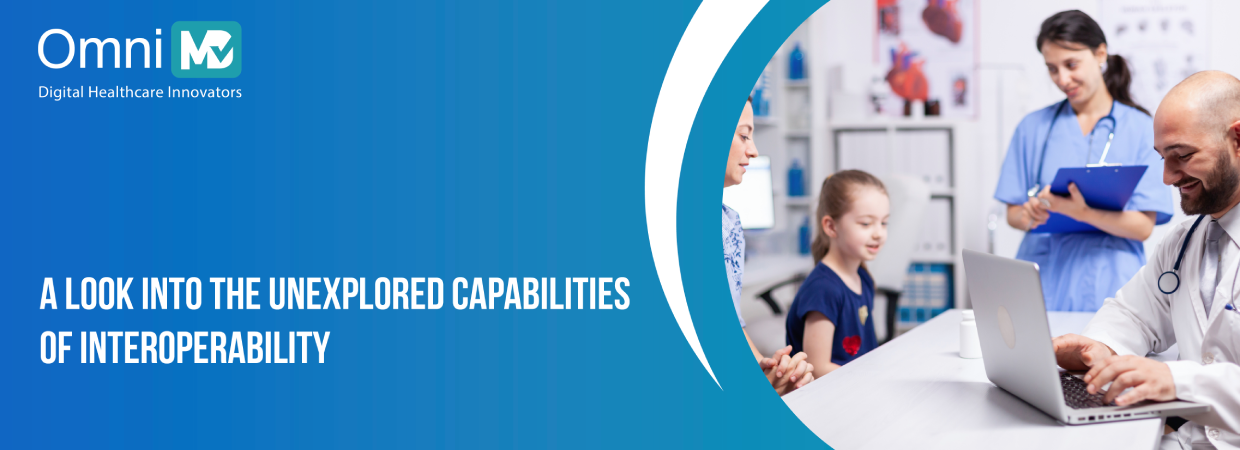How Interoperable Systems Improve Continuity of Care in Pediatrics
As the old adage goes, sharing is caring. In healthcare, and especially in pediatrics, this philosophy rings true. You, as a Pediatrician, manage a rich tapestry of information, from immunizations and growth charts to developmental milestones and parental concerns.
These details often come from different places, at different times, through different tools. Without the ability to share and connect that information meaningfully, early intervention and prevention can drift beyond reach just when a child needs them most.
For independent pediatricians, the challenge is even greater. Many work with limited staff and resources and often mistake health information exchange (HIE) for interoperability, a distinction that matters deeply when caring for children across multiple touchpoints.
While Health Information Exchange (HIE) enables the transfer of data between systems, like sending an email from one clinician to another, it doesn’t guarantee that the receiving system understands the message. It’s like emailing in English to someone who only reads Portuguese. Interoperability, on the other hand, not only exchanges data but also interprets it meaningfully, enabling the actionable, collaborative care that children truly need.
In this blog, as we explore the role of interoperability in promoting continuity of care in pediatrics, we go beyond technical jargon. Each section connects everyday pediatric workflows, from vaccinations to acute visits, with how interoperability transforms them from isolated events into coordinated care journeys. We begin with vaccination as it’s a perfect example of how small moments when supported by the right systems, leave a big impact.
Why Pediatric Care Can’t Rely on EHR Alone
You would agree that managing vaccines in pediatrics feels like a moving target. Parents switch providers, kids show up behind schedule, state rules change, and vaccine combinations can confuse even the best-trained staff.
A good pediatric EHR seems to work toward making this better. It helps track the full vaccine story, from what was given to when, where, by whom, and under what protocol. It flags what’s due, adjusts for missed doses, and stays updated when schedules shift based on public health alerts.
But vaccine records live in many places: pharmacies, schools, and even urgent care visits, and unless all those updates sync automatically, we end up chasing faxes or guessing if a parent’s paper card is current.
And this challenge isn’t small. According to the CDC, as many as 27% of children between 24-35 months are missing at least one recommended vaccine, often due to fragmented data across different care sites.
The consequences are even more serious in complex cases like catch-up schedules after international adoption, or when refugee children arrive with partial records in another language. If your system can’t cross-reference international vaccine equivalencies or pull immunization data from state registries and previous providers, the child may receive redundant vaccines, or worse, miss critical protection.
So, the real care happens when your EHR doesn’t work alone and:
- Connects with state immunization registries to instantly fetch prior vaccines, even when a child moves states or switches providers.
- Captures vaccine records from pharmacies and retail clinics, like a flu shot given at Cyclic Vomiting Syndrome (CVS) or a COVID booster from Walgreens and reconciles them into your timeline.
- Integrates school and daycare vaccine requirements, automatically surfacing what’s needed for enrollment and reducing parent panic during back-to-school season.
- Links vaccine administration to billing and inventory, so VFC (Vaccine for Children)-eligible doses are tracked, documented, and reimbursed without manual work or missed claims.
That said, an independent EHR may organize the vaccination workflow, but it is the interoperability that makes this workflow meaningful, visible, and coordinated across every care touchpoint. It turns a checklist into a trusted history, especially when that history spans countries, providers, and care settings.
How Interoperability Rethinks Developmental Care
Child developmental surveillance is all about noticing the small things early. A missed smile. A delayed ‘mama.’ A toddler who doesn’t quite steady himself. These moments matter. But between packed schedules, varied family inputs, and the volume of kids seen in a day, keeping tabs on every milestone feels like trying to hold running water.
A good pediatric EHR, embedded with Clinical Decision Support Systems (CDSS), steps in to nudge, prompt, and flag what needs to be noticed and when it needs to be noticed. For instance, during a 9-month visit, it might remind you to ask if the baby is sitting unsupported. At 18 months, it could alert you to a missing autism screen. And if documentation slips through, it gently points it out before it becomes a gap in care.
But milestone clues are rarely confined to one chart. A NICU discharge summary might note Grade III IVH. A parent might upload a speech delay concern through a portal message. An early intervention agency may fax a PT assessment showing low tone, which never gets scanned to the right chart.
Moreover, 1 in 6 children in the U.S. has a developmental delay, but fewer than half are identified before kindergarten, largely because relevant information is scattered across disconnected systems.
Interoperability brings this story together by:
- Pulling in developmental screens and Therapy notes from early intervention and regional centers, so you can build on prior evaluations instead of duplicating them
- Surfacing neonatal risk factors like IVH, PVL, or prolonged intubation from Neonatal Intensive Care Unit (NICU) discharge notes to adjust developmental expectations proactively
- Integrating caregiver observations, a parent’s concern about delayed pointing submitted through the portal becomes part of the visit plan, not a post-visit afterthought
- Connecting school and community feedback, such as IEP evaluations or OT reports, directly into your chart to support coordinated care with educators and therapists
That said, when a pediatric EHR with CDSS is powered by interoperable data, it becomes context-aware, understanding that a baby born at 27 weeks shouldn’t be flagged as delayed for not crawling at 9 months. Or that a child receiving speech therapy outside the system might already have supports in place. It transforms milestone tracking from a routine task into a responsive, personalized workflow that keeps pace with the child’s unique journey.
A Deeper Dive into the AI, Billing, Records, and Interoperability
During acute sick visits, which are often unpredictable, the challenge lies in focusing completely on examining the child while also listening to parents, recording everything carefully, and making quick decisions.
AI scribes take this burden off by listening during the visit and writing the clinical note automatically, capturing key parts like history, physical exam, diagnosis, and treatment plan. While the AI scribe is creating notes, the Revenue Cycle Management (RCM) system is working behind the scenes to assign the right billing codes based on what was documented. This helps ensure the visit is billed correctly and the practice gets paid on time. Accurate coding is especially important for urgent or after-hours visits, where things move quickly.
But here’s where complexity escalates: pediatric urgent care visits can originate outside your system, from school nurse referrals to after-hours telehealth providers. If those notes stay siloed or the AI generates codes that don’t align with your internal payer rules or documentation requirements, errors and denials pile up fast.
A recent study found that 19% of claims are denied due to documentation or coding discrepancies, and many of these occur when care is delivered in fragmented environments, retail clinics, external telehealth platforms, or urgent care centers not fully integrated into the child’s primary record.
All of this works more efficiently when AI scribes, RCM, and the EHR are interoperable, where:
- AI-generated notes flow directly into the EHR, creating clean, compliant documentation that reflects the pediatrician’s thought process without requiring hours of typing.
- Billing codes are auto-extracted from clinical documentation, aligning visit notes with payer expectations to minimize denials and speed up collections
- Outside care episodes, like urgent care, pharmacy visits, or after-hours telehealth, are automatically imported, so you’re not managing care based on guesswork or parent memory.
- Follow-up coordination becomes smoother, with referral notes, labs, and imaging results available inside the pediatric record before your next well visit.
Therefore, when these systems speak the same language, a rapid strep test done at a pharmacy clinic is visible before you prescribe another antibiotic. A follow-up note after a seizure-related ER visit flows in time to adjust your care plan. Documentation supports coding, and coding supports care continuity.
How is OmniMD Connecting the Dots in Pediatric Workflow?
So, in essence, interoperability requires systems to exchange, interpret, and apply information across varied clinical settings. OmniMD addresses this need with its powerful interoperability engine designed to synchronize pediatric workflows across providers, facilities, and care platforms. It uses standards like HL7 and FHIR to ensure compatibility across modern and legacy systems.
But the real strength lies in its ability to map, transform, and normalize disparate data types, so pediatric-specific data like immunization histories, developmental milestone evaluations, growth charts, and urgent visit summaries are immediately accessible, understandable, and actionable inside the EHR.
OmniXchange, our interoperability platform, connects pediatric providers with labs, pharmacies, registries, and other healthcare systems to reduce delays and eliminate manual entry.
Clinical Decision Support tools are enhanced with richer context from connected systems, helping pediatricians make informed decisions quickly for their youngest patients.
AI-generated notes and billing codes flow seamlessly between systems, creating a unified experience across documentation, diagnosis, and reimbursement tailored to pediatric needs.
We also support this infrastructure with high-reliability hosting, HIPAA compliance, and scalable service models. With thousands of live interfaces and millions of patient records exchanged, it has the depth and technical maturity to support both independent pediatric practices and larger pediatric networks.
Are you ready to take the strategic leap? Let’s connect.

Interoperability in Pediatrics Starts Here
Streamline care. Connect data. Support every child.

 Written by Neha Singh
Written by Neha Singh
 Reviewed by Shivani Joshi
Reviewed by Shivani Joshi